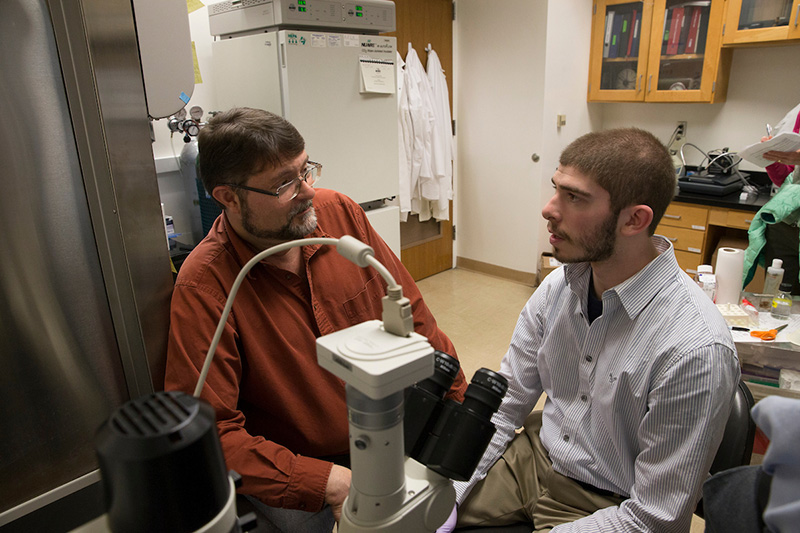
Miami University receives more than $1 million from the National Science Foundation for new research equipment

A second spectrometer in the Ohio Advance EPR Lab (OAEPRL) at Miami makes the university one of only handful with two.
By Heather Johnston, office for the advancement of research and scholarship
Miami University received two grant awards totaling nearly $1.1 million in the 2017 round of competition for the National Science Foundation’s Major Research Instrumentation (MRI) program. The national rate of success for proposals submitted to the program is only 20 percent.
“Given how competitive the MRI program is, it’s unusual that any institution would receive two awards in a single year,” said Jim Oris, Miami’s associate provost for research and scholarship. “It’s certainly a first at Miami.”
The National Science Foundation awards will support Miami’s acquisition of a pulsed electron paramagnetic resonance (EPR) spectrometer and a fluorescence activated cell sorting (FACS) system. The pulsed EPR spectrometer will be housed in the Ohio Advanced EPR Lab. The FACS system will be housed in the Center for Bioinformatics and Functional Genomics.
Pulsed EPR spectrometer enhances world-class facility
With the addition of the new spectrometer, the Ohio Advanced EPR Lab (OAEPRL) located at Miami will become one of just a handful of facilities in the world to have multiple pulsed EPR spectrometers, according to Gary Lorigan, professor of chemistry and biochemistry and principal investigator on the MRI proposal.
“There aren’t many EPR facilities in the world that have these powerful capabilities,” said Lorigan. “We already have a world-class facility here at Miami. Having a second instrument really puts us over the top.”
Spectrometers allow researchers to infer physical characteristics of matter based on the way it interacts with light or other radiative energy. An EPR spectrometer characterizes the way unpaired electrons in certain molecules or atoms spin when subjected to a magnetic field.
Pulsed EPR is used to assess certain characteristics that can’t be determined with EPR techniques that apply a continuous wave of energy. EPR is used in research in a range of fields, from biology to chemistry to physics. Read about the specific application of EPR to Lorigan’s research in this post.
Although the new pulsed EPR instrument doesn’t bring new capability to the lab – it will function very similarly to the existing one – it does bring expanded capacity. Currently, the lab’s single EPR spectrometer runs 24 hours a day, seven days a week, and still has a three-month backlog of samples that need to be analyzed.
The new spectrometer will alleviate the current backlog and enhance the productivity of researchers at Miami, including Lorigan, and his department of chemistry and biochemistry colleagues Mike Crowder, Carole Dabney-Smith, Michael Kennedy, Rick Page and David Tierney, as well as Natosha Finley from the department of microbiology. It will also benefit the work of other researchers in Ohio and surrounding states who rely on the lab for their experiments.
Mike Robinson, left, works with former student and Goldwater Scholar Blake Rasor.
FACS system opens up a whole new game in genome editing
If the new EPR spectrometer levels up an already top-notch facility, the new FACS system opens up a whole new game. The system physically separates cells into groups based on a defined set of characteristics. This capability will optimize experiments that use the new CRISPR-Cas9 gene engineering technology.
“CRISPR-Cas9 genome editing is revolutionizing biology, and our research will rely more and more heavily on it,” said Paul James, associate professor of biology and a co-principal investigator. “The FACS system allows higher throughput analysis for CRISPR-Cas9 experiments, so it will raise our games and allow us to do a lot more.”
Although Miami already has flow cytometers capable of identifying certain cell characteristics based on how each individual cell scatters light as it passes through a laser beam, only a FACS system can use this information to physically separate mixtures of cells into different populations.
Researchers using CRISPR-Cas9 to manipulate a cell genome often tag the manipulated cell with a fluorescent marker. The researchers can then use the FACS system to both identify and isolate cells containing the manipulated genome.
Miami’s FACS system will support research in multiple other departments, including chemical, paper, and biomedical engineering; biological sciences; microbiology; and physics.
Altogether, 12 key personnel are included on the NSF grant. Their work falls into three “themes”:
Cellular reprogramming and regeneration:
- Mike Robinson (biology) co-principal investigator
- Katia Del Rio-Tsonis (biology)
- Justin Saul (chemical, paper, and biomedical engineering)
- Jessica Sparks (chemical, paper, and biomedical engineering)
- Paul Harding (biological sciences)
Physiology, immunology, and metabolism:
- Paul James (biology)
- Tim Wilson (microbiology)
- Kathy Killian (biology)
- Lori Isaacson (biology)
- Paul Urayama (physics)
Microbial ecology:
- Rachael Morgan-Kiss (microbiology)
- Craig Williamson (biology)
The NSF MRI program puts a strong emphasis on training the next generation of researchers, and each of Miami’s two funded proposals will provide graduate and undergraduate students opportunities for training and hands-on use of the new equipment.
Both teams also plan to reach beyond the borders of Miami. Two members of Lorigan’s team include students from Central State University in their labs, and these students will receive training to use the new EPR instrument. Robinson’s team, in collaboration with Miami’s Hefner Museum of Natural History, will create FACS-related material geared toward K-12 students, to be used in the museum’s STEM educational outreach.

